Geocomposites
Geocomposites are manufactured by the combination of HDPE geonets and non woven geotextiles to improve drainage, reinforcement and filtration in civil engineering projects.
Overview
A geocomposite is a material constructed by combining two or more geosynthetic products, developed for its versatile functionality in civil construction. They were invented with the larger purpose of drainage of the ground. Today, due to its wide usage a geocomposite often is synonymous with the combination of a drainage net, and a geotextile that can be used anywhere from a basal reinforcement in embankments, or behind retaining walls.
What are geocomposites?
Geocomposites are made by combining geosynthetics such as geonets, geomembranes, geogrids, or geotextiles. These composites are designed to improve drainage, reinforcement, and filtration capabilities of the soil, or material they’re laid over.
At Strata Geosystems, our StrataDrain combines geonet and geotextile. It is utilized for three primary applications: drainage, separation, and reinforcement. This geocomposite manages water flow, prevents soil mixing, and improves the structural integrity of systems such as retaining walls and roadways. This is a result of hydrostatic pressure reduction.
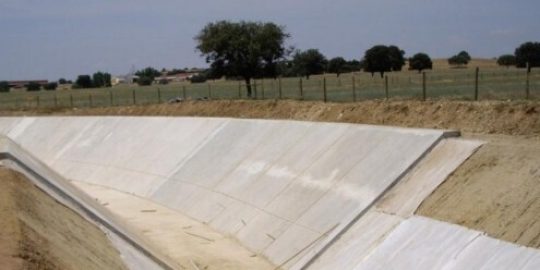
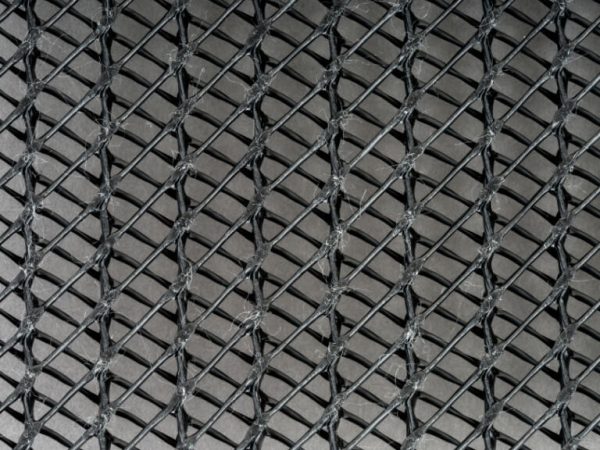
What are geotextiles and geonet geocomposites?
StrataDrain geocomposites by Strata Geosystems does not compromise on quality. Geotextiles in our geocomposites, made from polypropylene, permit water permeability while maintaining strength and durability. These also retain the soil particles (4 to 7mm thickness) due to its perforation size (ASO). The geotextile rolls of Strata Geosystems are of wider widths(5.8m/19ft) and customizable lengths , affecting filtration capabilities and tensile strength.
HDPE (high-density polyethylene) geonets used in StrataDrain geocomposites are created through a process of extrusion. A network of interconnected ribs are formed with open spaces for fluid movement. The ribs allow horizontal drainage, enabling water or leachate flow easily across the surface.
What do geonet- geotextile geocomposites do?
StrataDrain offers a 100 year life Our EPD verified product withstand mechanical and chemical stresses, including high pH values, extreme temperatures, and elevated pressure conditions. Our drainage solution uses HDPE due to high tensile strength and resistance to environmental factors like UV radiation and chemical degradation.
Water enters through the geotextile filter, flows through the geonet’s three-dimensional conduit, and is then evacuated through a drainage pipe or into surrounding soil. Thus, geocomposites prevent water accumulation and structural instability.
Geocomposites prevent mixing of subgrade soils from aggregate layers or granular fills, or finer soil types. This maintains the load-bearing capacity and reduces settlement. Geotextiles and geonets interact with the soil through frictional, cohesive, and adhesive forces, resisting soil particle movement. The geotextile acts as a physical barrier stopping soil particles from entering the geonet, thus clogging the drainage pathways.
Reinforcement is not one of the primary functions of geocomposites, it works to improve load bearing. Geonet and geotextile layer redistribute the load, reducing the stress concentrations on the soil.
Geonet provides tensile strength by resisting deformation and failure under load. Geotextile layers limit the formation of cracks and fissures in the soil, which could lead to structural instability. In bridge abutments or retaining walls, the reinforcement function of StrataDrain™ maintains structural integrity under varying load conditions, especially in heavy traffic prone areas.

Geocomposites allow water to flow freely into the drainage network created by the geonet. This process stops clogging of drainage systems thus preventing water pooling and increased pressure on structures. Effective in stormwater management, erosion control, and infrastructure protection, proper filtration maintains soil stability by preventing sediment transport.
How do geonet-geotextile geocomposites work?
Geonets have a high void ratio ranging from 80% to 95%, designed for efficient water drainage. The void ratio is the ratio of the volume of voids to the total volume of the geonet. Geonet’s open channels assist rapid movement of water by preventing water accumulation in surrounding soils. Geonet’s drainage efficiency is further enhanced by its hydraulic conductivity, which is several magnitudes higher than that of the surrounding soil.
The interaction between the geonet core and the geotextile layers maintain optimal performance of geocomposites, hence structures that’s built to last. Three key factors affect the geonet- geotextile interaction – the permeability and pore size of the geotextile, the thickness and aperture size of the geonet, and the bond strength between the geotextile and geonet. Selecting a geosynthetics manufacturer like Strata Geosystems is crucial for meeting your project requirements. Our StrataDrain geocomposites modify soil behaviour by influencing key properties such as hydraulic conductivity, soil settlement, and stability.
At the microscale, geotextile fibers interact with individual soil particles and at the macroscale, fibers interact with larger soil aggregates or clusters. In practical terms, this interface shear resistance enhances stability in structures like retaining walls or embankments under stress. The interaction between geonet and the adjacent geotextile creates a shear resistance at their interface. This resistance is due to the mechanical bond formed between the geotextile’s yarns and surrounding soil. As yarns penetrate the soil, a complex network of fiber-soil interactions inhibits sliding or movement between layers.
At the microscale, geotextile fibers interact with individual soil particles and at the macroscale, fibers interact with larger soil aggregates or clusters. In practical terms, this interface shear resistance enhances stability in structures like retaining walls or embankments under stress.
Applications of geonet-geotextile geocomposites
The choice between different types of Strata Geosystems geocomposites depends on the project requirements and soil conditions. StrataDrain is beneficial in areas with high water flow, erosion, unstable soil, or where containing chemical/biological contamination is needed. It is also ideal for remote or hard-to-reach locations where traditional methods like granular drainage or piping systems may not be feasible due to accessibility or high installation costs.
Landfills
In landfill capping, geocomposites minimize water infiltration, reduce erosion risks, and control methane generation by promoting aerobic conditions within the waste mass. Changes detected in fluid pressure or flow rates can signal potential leaks.
In lining and filtration, composites reduce aggregate consumption, increase landfill airspace, and speed up construction. By protecting the geomembrane liner and preventing clogging of the drainage layer, a sustainable and environmentally secure waste disposal solution is ensured with StrataDrain.

Civil works
Vertical drains have a plastic core wrapped in a geotextile filter. These are installed in bridge abutments, retaining walls, and road construction to reduce hydrostatic pressure. By shortening the consolidation process, vertical drainage minimizes delays of the construction projects and improves overall efficiency.
Vertical drainage, also known as prefabricated vertical drains or wick drains, extend vertically into the ground and speed up the consolidation of saturated cohesive soils, such as clays and silts. Vertical drains create a pathway for pore water to escape, reducing the time for soil to settle – which usually takes years due to the low permeability of these soils.
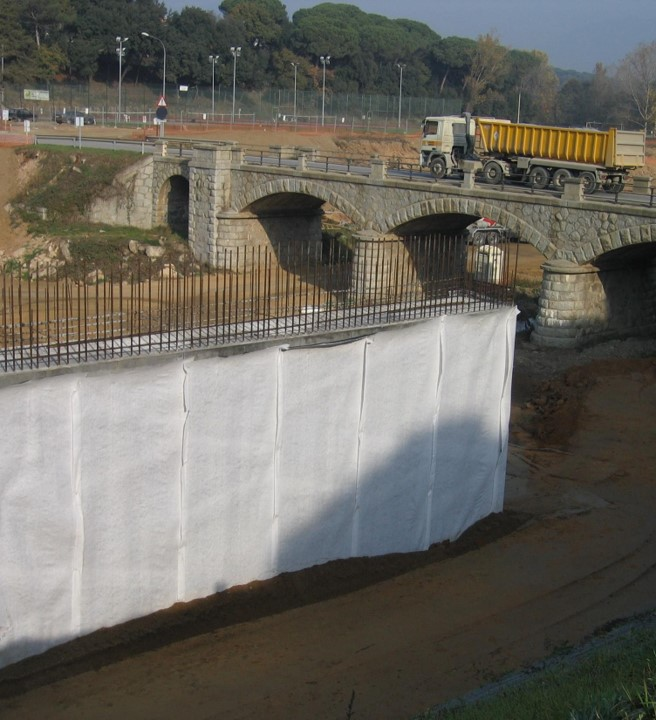
In horizontal drainage, we manage subsurface water flow by installing drainage systems parallel to the ground surface. This minimizes water accumulation in areas prone to saturation, such as embankments, slopes, and agricultural fields. By using perforated pipes and geonets, these drainage systems redirect water away from critical structures, reducing soil instability, erosion, and waterlogging. To add another layer of assurance, we use geotextiles, to filter out sediments, retaining the integrity of the drainage pathways.
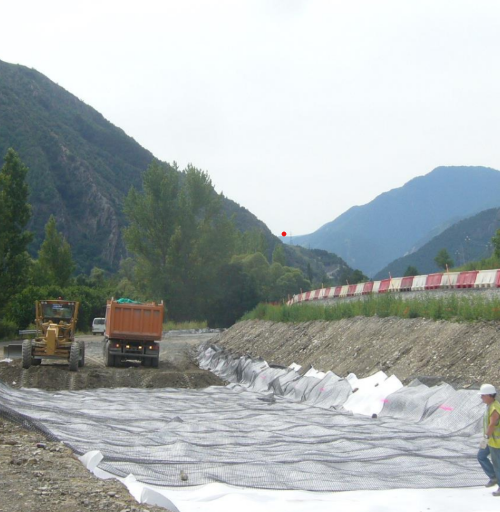
Longitudinal drainage manages surface and subsurface water along linear features such as roads, fields, or agricultural areas. This method has a network of drains or ditches that run parallel to the direction of flow. With efficient water movement, this approach reduces the risk of waterlogging and promotes sustainable land use practices.

By using geocomposites instead, erosion is controlled by stabilizing the soil and reducing the risk of washout. Our innovative StrataDrain™ geocomposites serves a dual function ; reduces fluid pressure buildup by allowing fluids to drain freely, and acts as a leak-detection system for the subsurface layer, channeling any leaked material outward.
Lightweight and flexible, they are easier to install than traditional drainage solutions. Likewise, these composites adapt to various channel shapes and sizes, being suitable for both urban stormwater management systems and rural drainage ditches.
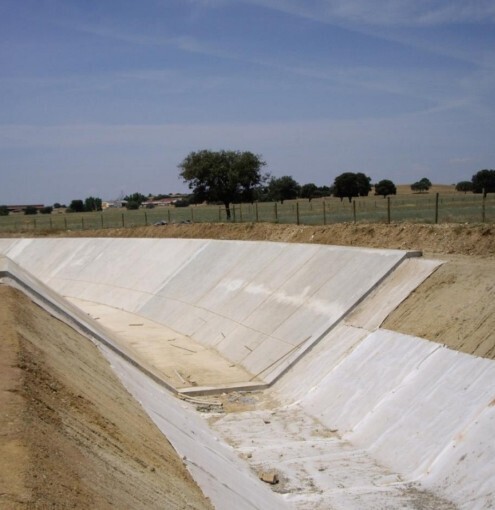
In tunnel construction, managing groundwater ingress is crucial for safety and efficiency during excavation and operation phases. Tunnel structures control water flow using geocomposites through rapid drainage away from tunnel walls while filtering out fine particles. By creating a reliable barrier against groundwater infiltration, geocomposites reduce the risk of flooding within tunnels, minimize delays, and maintain dry conditions around tunnel linings.
When constructing roadways or airfields over soft or unstable soils, geocomposites distribute loads more evenly across the subgrade enabling efficient drainage. A layer beneath pavement structures mitigate differential settlement or cracking caused by moisture fluctuations in the subgrade. Through separation and drainage functions simultaneously, geocomposites prolong pavement life and reduce maintenance costs over time.
On top of that, geocomposites direct thinner pavement sections without compromising performance—an advantage that leads to cost savings during construction. In high-traffic areas this application enhances roadway performance while addressing challenging soil conditions.
Mining operations
Geocomposites manage water runoff from tailings piles, reducing the risk of contamination and environmental degradation. By creating stable separation layers, geocomposites prevent the mixing of tailings and other materials, ensuring the structural integrity of Tailings Storage Facilities (TSFs). This stabilization minimizes the risk of erosion, landslides, and other environmental hazards.
Composites facilitate efficient leaching processes by managing fluid flow through the heap material. The structure created by the geonet channels optimal drainage while limiting clogging from fine particles, which can hinder leaching efficiency. This maximizes resource recovery during the ore extraction process while minimizing environmental impact. Their tensile strength supports the weight of heap materials evenly, reducing localized stress points that could lead to deformation or failure. Additionally, these composites serve as a protective barrier against potential leaks from the heap leach pads into the surrounding environment
Green infrastructure
Geocomposites in green infrastructure projects effectively manage stormwater runoff. When used in bioswales or green roofs, Strata Geosystems geocomposites ensure proper drainage without compromising soil health or plant growth. The filtration function of geotextiles removes pollutants like heavy metals, nutrients and oils from the water before it enters natural waterways.
By reducing the amount of polluted runoff, geocomposites protect aquatic habitats and mitigate flooding in urban areas. By promoting natural hydrology by allowing rainwater to infiltrate the ground, geocomposites also replenishes groundwater supplies.
Erosion control
When used on slopes or riverbanks, StrataDrain offers a protective, stabilizing layer leading to natural vegetation growth. When rainwater or surface runoff interacts with a geonet-geotextile geocomposite on a slope, the geotextile layer filters out sediments with excess water to drain away. This mitigates the formation of rills and gullies which can lead to severe erosion.
Geocomposites are also effective in heavy rainfall or rapid snowmelt areas. By managing water flow and reducing soil displacement, these geosynthetics protect infrastructure and natural landscapes from degradation.
How are StrataDrain™ drainage composites manufactured?
StrataDrain drainage geocomposites by Strata are manufactured in the state-of-the-art manufacturing plant located in India in three phases: Extrusion, lamination cum slitting and packing.
We start our extrusion process with drying high-density polyethylene (HDPE) granules and additives to remove any moisture. Once that’s done, the carefully prepared material is transformed into durable polypropylene (PP) or polyethylene (PE) plastic nets.
The next step is lamination and slitting which is the precise lamination of geonets and geotextiles using thermal heating. Finished products are then packed in round or roll form and wrapped in HDPE sheets. For export, palletizing with stretch wrap and wooden pallets is offered. Our eco-friendly manufacturing guarantees no chemical spillage or effluent discharge throughout the process.

Strata Geosystems geocomposite-( Infographics)
StrataDrain is an advanced geosynthetic drainage composite that adheres to the stringent guidelines set forth by the Ministry of Road Transport and Highways (MoRTH) under section 700-10. This product is both ISO and CE certified, guaranteeing compliance with international quality and safety standards. StrataDrain has also undergone rigorous testing at GAI-LAP and NABL accredited laboratories.
Designed for high performance, StrataDrain is available in configurations of 2 and 3 strands, and renders high flow capacity with low creep properties. Our drainage geocomposites are available in three types; StrataDrain SD – adaptability in all applications, StrataDrain TD- High performance in high pressure and StrataDrain HF- the best option for landfill cappings.
StrataDrain are suitable for applications such as sheet interceptor drains behind retaining walls and internal drains for reinforced slopes. The product features a thickness range of 4 to 7 mm, utilizing a lamination of polypropylene geotextiles (PP GTX) with weights from 100 to 1000 gsm.
Our manufacturing process prioritizes quality assurance, using only the highest quality virgin polypropylene materials. StrataDrain drainage geocomposites incorporate UV-resistant raw materials to enhance durability and lifespan. These features make StrataDrain stands out in geotechnical applications due to its innovative features and commitment to excellence
Strata geosystems geocomposite
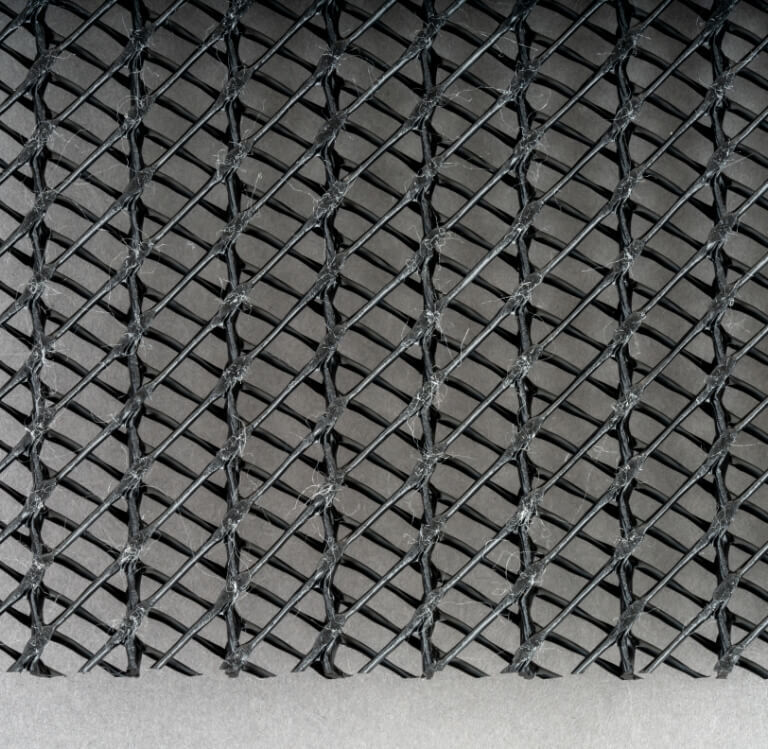
| StrataDrain™
Why choose Strata Geosystems geocomposites?

Poor quality geocomposite
- Non-compliant with industry standards
- Poor flow capacity, prone to clogging
- Susceptible to deformation under load
- Sub-standard material quality
- Limited product variety
- Unreliable performance
- Complex installation

Strata Geosystems high strength geocomposite
- StrataDrain is MoRTH compliant as per section 700–10
- Exceptional drainage efficiency
- Designed to withstand high compressive forces
- High durability and chemical resistance
- Available in three types- StrataDrain SD, StrataDrain TD, and StrataDrain HF.
- Exceptional reliability
- Ease of installation
